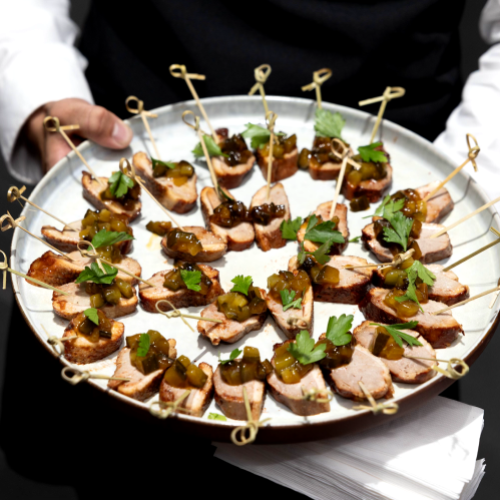Corporate events often require a delicate balance between professionalism and a relaxed atmosphere. Canapé catering presents an ideal solution, offering a variety of delicious options that are easy to serve and encourage meaningful social interactions. To help ensure your catering aligns with your event goals, here is a detailed guide on the key considerations to keep in mind when planning your corporate canapé catering.
1. Is There Cooking Equipment Onsite?
Before finalising your catering plans, it’s important to determine whether your venue has the necessary cooking equipment. Some canapés require specific preparation methods that may involve stoves, ovens, or grills. If your venue lacks the appropriate facilities, don’t hesitate to discuss alternatives with your caterer. Many specialised caterers have portable solutions or can prepare dishes in advance, ensuring that your food is fresh and of the highest quality. Clear communication regarding equipment access will help avoid any surprises on the day of the event.
2. Do You Require Crockery and Serving Equipment?
An often-overlooked aspect of catering is the need for appropriate serving utensils and crockery. While canapés are typically served on platters or in individual portions, it’s essential to confirm whether your venue can provide the necessary items or if your caterer will need to supply them.
3. Are All Drinks Already Cold?
When planning your catering, make sure all drinks are chilled and ready for your guests. If your caterer is handling beverage service, confirm they have the necessary refrigeration options available.If guests will be mingling and enjoying canapés, it’s vital that drinks are easily accessible. Consider setting up a beverage station or providing waitstaff to circulate drinks, enhancing convenience and creating a welcoming atmosphere for your attendees.




4. Have You Catered for Dietary Needs?
Accommodating dietary restrictions is essential. Before finalising your menu, gather information on any dietary preferences or restrictions from your attendees. Common considerations might include vegetarian, vegan, and gluten-free. Typically, caterers will provide alternatives to your selections, allowing everyone else to enjoy a normal menu.
5. Guest Count: Ensure Adequate Food and Seating Arrangements
Knowing how many attendees to expect helps ensure that there is sufficient food. When planning, it’s wise to account for possible last-minute changes. A helpful guideline is to plan for about 3-4 canapés per person per hour, depending on the duration of your event. This will help you order an appropriate quantity to keep your guests satisfied and engaged.
6. Location: Assess Venue Facilities
The logistics of your venue can significantly influence the catering experience. Consider the venue’s facilities, including kitchen space, catering access, and setup requirements. Does the venue allow for easy access for caterers to set up and serve?
Evaluating the layout is also crucial; it should facilitate mingling and enjoyment of the canapés. If possible, conduct a walkthrough with your caterer to discuss the most effective layout for tables, chairs, and serving stations. This proactive approach can help identify any challenges early on.
7. Beverage Services: Planning Drink Options
Drinks are a key element of any corporate event, so planning your beverage service is essential. Decide on the range of drinks to offer, from simple soft drinks and water to a selection of wines and cocktails. Including a signature cocktail can add a unique touch that makes your event memorable.
Another consideration for the drink service is the bar itself. Typically, we offer our clients one of two options:
1. We can supply a bar, which will incur a surcharge.
2. We can create a makeshift bar by placing a tablecloth on a bench or tabletop.
In conclusion.
When planning your next corporate canapé event, consideration of these factors can greatly enhance your guests experience. By ensuring you have the necessary equipment, accommodating dietary needs, and confirming your guest count, you create a welcoming environment that fosters engagement and connection.


